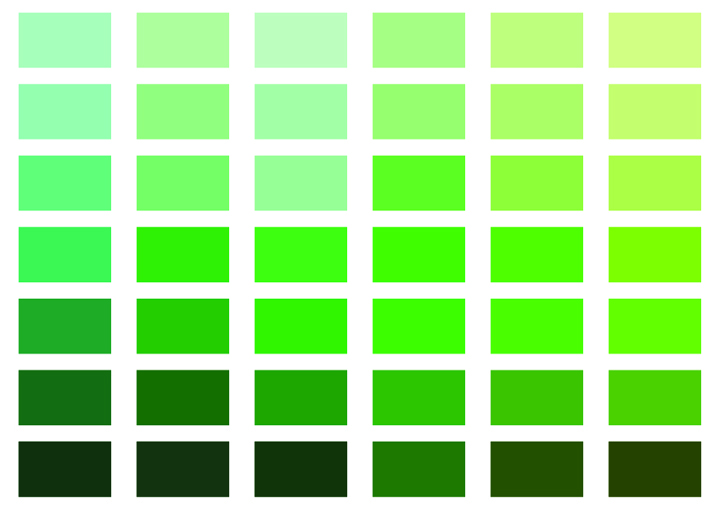Green is one of the most abundant colors on our planet, found in nature and elsewhere. It’s a gorgeous color that thrives in the natural world. You’ll find all sorts of different shades of green in plants, grass, and trees.
And you’ll need to use the color green in all sorts of artwork and graphic design. So, this complete guide to green color names should come in handy! Whenever you need a specific.
So, let’s take a closer look at the various shades of green and their names!
A Guide to Shades of Green with Names
If you’ve ever wondered about all the different green names, this guide is for you. I’ll walk you through the most common shades of light green and dark green names.
True Green

Hex Code: #089404
I’ll start with true green, also known as pure green. It’s the color you get when you mix equal amounts of blue and yellow together. So, it sits midway between yellow and blue on the color wheel and doesn’t have strong undertones of either color.
Once you’ve mixed true green paint, you can then make many other shades of green. All you need to do is add a little yellow, blue, white, or black. It all depends on your desired shade of green.
True green is a medium green that’s quite bright without appearing to be neon. It’s very vibrant, and you may find this color in nature. But it works just as well in all sorts of paintings. This color conveys a sense of security, balance, and peace.
Forest Green

Hex Code: #014421
Forest green is a very rich, deep shade of green. As the name suggests, it comes from the color of forest trees. It’s a slightly muted color that isn’t too bright or too dull. So, it’s a close approximation of the organic shade found in nature. Forest green is one of the darker greens. It’s deeper than Hunter green but not as dark as Pthalo green.
Persian Green

Hex Code: #00A693
Persian green is a gorgeous shade somewhere between turquoise and teal. It’s a distinctive shade often used in ceramic tiles in Persia and the region. Persian green has heavy blue undertones and is much closer to blue on the color wheel.
Harlequin Green

Hex Code: #3FFF00
Harlequin green is a vivid, bright shade of green. It’s a light to medium color, and you’ll find it next to Chartreuse green on the color wheel.
This color is perfect if you want to add vibrancy to your painting. It’s a bold color to use in graphic design, but it will surely capture people’s attention.
Emerald

Hex Code: #50C878
Emerald is one of the most well-known shades of green. And, of course, it takes its name and color from the precious jewel of the same name. Other words for this shade include Paris green and imperial green. It’s a beautiful color that’s not too light, not too dark – it’s just right!
Hunter Green

Hex Code: #355E3B
If you’re after a deep, dark green, hunter green could be perfect for your needs. It’s a rich green with yellow and teal undertones. It’s also one of the deepest green colors found in the natural world. When you use Hunter green, it will bring elegance, stability, and a slight seriousness to any piece of art.
Neon Green

Hex Code: #39FF14
In contrast to Hunter green, neon green is one of the brightest shades of green. It shines off the page and is one of the most light-hearted and fun greens you can use. But neon green won’t work in all situations, as it’s such a bright and vivid color. You’ll need to think carefully about the appropriate color.
Olive Green

Hex Code: #708238
Olive green is a distinctive color, taking its name from the olive tree and its green fruits. This shade of green is an earthy color with yellow undertones. It’s also on the warmer end of the spectrum and works well with many other shades. You can use this color as a neutral to balance out your compositions.
Phthalo Green

Hex Code: #123524
Phthalo green is one of the darkest greens you’ll find in your painting set. It’s even described as green-black by some artists. The full name of this color is phthalocyanine green, but most people know it by the shorter name.
Phthalo green comes in handy when you need a deep green. But you can also add a little yellow to alter the shade and make it lighter. It’s a cooler shade with blue undertones.
Yellow Green

Hex Code: #9ACD32
As the name suggests, this shade of green is bright with heavy yellow undertones. So, you’ll find it closer to yellow than blue on the color wheel. In fact, it’s made up of equal amounts of green and yellow and generally is a warmer shade.
Yellow-green is a lovely, vibrant shade of green that oozes freshness. It’s a great color to use for a springtime scene or when you need to make a green gradation.
Midnight Green

Hex Code: #004953
Imagine the color of a forest at night, and you’ll get something close to this shade of green. Midnight green is a deep, rich shade, although it’s not as dark as you might expect. Instead, it has a lot of blue mixed in, and some may even class it as a shade of blue. It is very similar to teal and is sometimes referred to as Eagle green.
Mint Green

Hex Code: #98FB98
Mint is a herb that is bright, clean, and refreshing. And like the herb, the mint green color is just as fresh and cheerful. This color will brighten up any painting and also is very attractive. So, it works well in branding, graphic design, and even interior design.
Moss Green

Hex Code: #8A9A5B
Moss green is another green name that takes its inspiration from nature. Moss is a small plant that grows in damp, cooler locations in forests and woodland. It has an earthy green color with a tinge of brown. You’ll find moss green ideal when you need to use a natural, warm color. It also makes a great contrast to bolder, darker colors.
Tea Green

Hex Code: #D0F0C0
Tea green is one of the lightest shades of green you’ll find. It’s a pastel shade made by adding white to green, so it’s very pale. But it has a delightful color that works well to balance out richer, brighter shades. This color pairs well with darker purples and pinks. Or, you can combine it with other cool, light shades for a very calm and tranquil painting.
Kelly Green

Hex Code: #4CBB17
Kelly green is a well-known shade of green, and it’s also very bold and bright. This color is associated with Ireland and St. Patrick’s Day. It even takes its name from the common Irish surname of Kelly.
As it’s such a dramatic color, I recommend using Kelly green as an accent color in your painting. Too much of this shade, and your artwork could become a little garish.
Army Green

Hex Code: #4B5320
Army green is a dark, muted green that’s ideal for camouflage. And that’s exactly where it gets its name from. This color is used by the army to blend in with their surroundings.
Army green is a shade that won’t stand out in the great outdoors. So, it allows soldiers to move about without being spotted.
This shade is instantly recognizable as a military color, but you can use it in many ways in your artwork. This color is sometimes referred to as dark olive green.

Shades of Green Color FAQ
How many shades of green are there?
As you’ve been, there are many different shades of green. They range from the lightest greens to very dark green and every color in between. You can bookmark this page to refer to whenever you need to compare the various types of green!
What is the name of dark green?
There are several different types of dark green. Some of the most common dark greens include Pthalo green, forest green, and hunter green.
What are the names of shades of light green?
Some of the lighter shades of green include mint green, tea green, and celadon. These colors contrast nicely with the darker greens mentioned above.

Related articles:
- What Colors Make Gold Paint
- +40 Shades Of Blue Color
- What Colors Make Green?
- What Colors Make Blue?
- 70+ Shades of Purple Color
- Colors Of The Rainbow In Order
- What Colors Make Orange?
- What Colors Make Black? A Guide for Artists
More related articles
The Wrap Up
As you can imagine, you can’t get away without using green in your artwork or graphic design. It’s a vibrant, natural color that brings freshness and vigor to your creative work.
And now, you should be an expert on the different kinds of green! You’ll know your forest green from emerald and olive from fern green. So, you’ll also find it much easier to pick the perfect shades of green for your color palette!
Let me know if you have any questions about the different types of green below. And don’t forget to follow Proactive Creative on Pinterest. I’ll keep you up to date on all the best content and tips for creative professionals.





